stop start CHRYSLER SEBRING COUPE 2005 2.G Owner's Manual
[x] Cancel search | Manufacturer: CHRYSLER, Model Year: 2005, Model line: SEBRING COUPE, Model: CHRYSLER SEBRING COUPE 2005 2.GPages: 394, PDF Size: 2.47 MB
Page 203 of 394
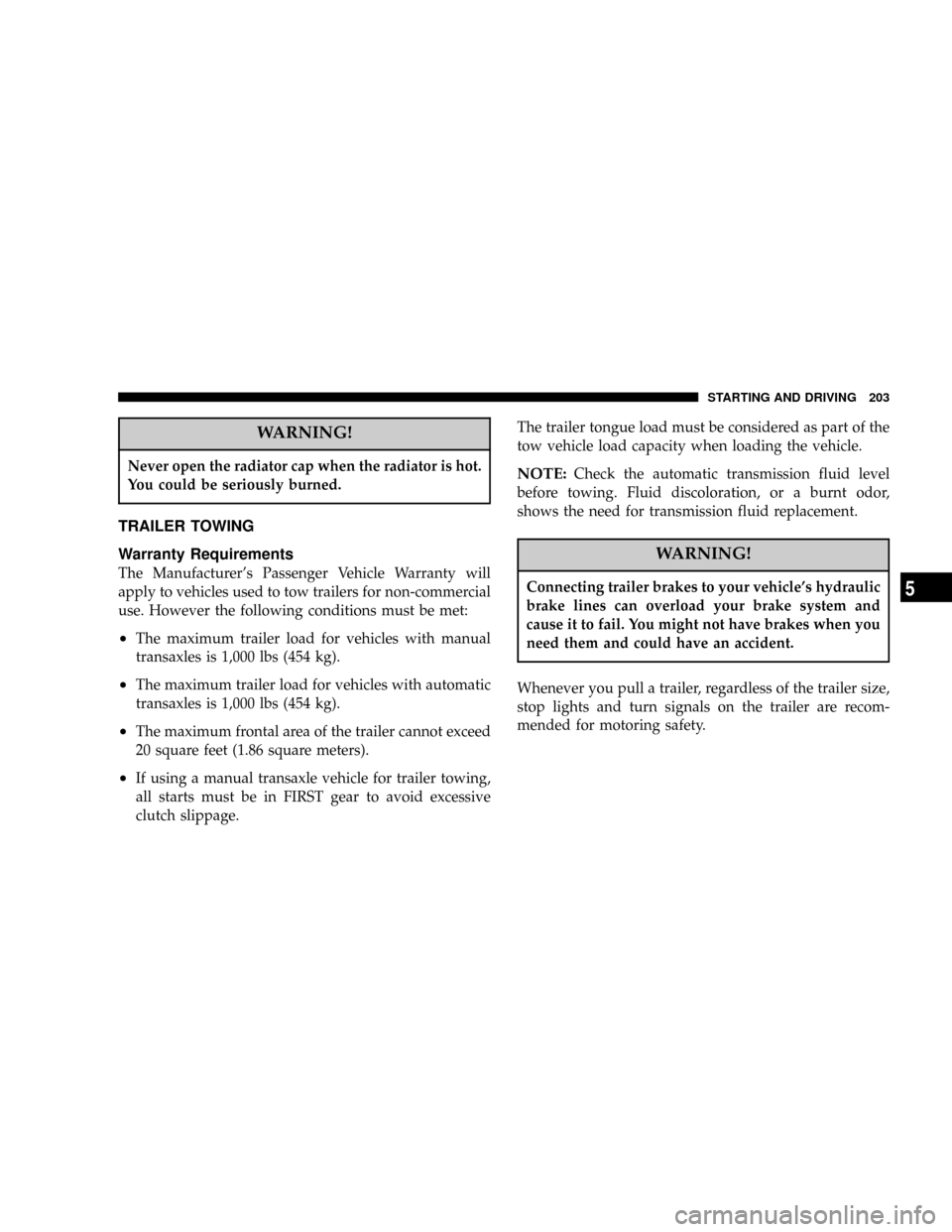
WARNING!
Never open the radiator cap when the radiator is hot.
You could be seriously burned.
TRAILER TOWING
Warranty Requirements
The Manufacturer's Passenger Vehicle Warranty will
apply to vehicles used to tow trailers for non-commercial
use. However the following conditions must be met:
²The maximum trailer load for vehicles with manual
transaxles is 1,000 lbs (454 kg).
²The maximum trailer load for vehicles with automatic
transaxles is 1,000 lbs (454 kg).
²The maximum frontal area of the trailer cannot exceed
20 square feet (1.86 square meters).
²If using a manual transaxle vehicle for trailer towing,
all starts must be in FIRST gear to avoid excessive
clutch slippage.The trailer tongue load must be considered as part of the
tow vehicle load capacity when loading the vehicle.
NOTE:Check the automatic transmission fluid level
before towing. Fluid discoloration, or a burnt odor,
shows the need for transmission fluid replacement.
WARNING!
Connecting trailer brakes to your vehicle's hydraulic
brake lines can overload your brake system and
cause it to fail. You might not have brakes when you
need them and could have an accident.
Whenever you pull a trailer, regardless of the trailer size,
stop lights and turn signals on the trailer are recom-
mended for motoring safety.
STARTING AND DRIVING 203
5
Page 228 of 394

will show the track number and index time in minutes
and seconds. Play will begin at the start of track 1.
Seek Button
Press the top of the SEEK button for the next selection on
the CD. Press the bottom of the button to return to the
beginning of the current selection.
FF /TUNE/ RW Button
Press the FF (Fast Forward) button and the CD player
will fast forward through the tracks until the button is
released.
Random Play
Press the button while the CD is playing to activate
Random Play. This feature plays the selections on the
compact disc in random order to provide an interesting
change of pace. The CD changer stays in the random
mode when changing to the next disc.
NOTE:The changer will not random play between
discs.
Press the top of the SEEK button once to move to the next
randomly selected track. Press the bottom of the SEEKbutton to go back to the beginning of the track. Press
button for a second time to stop Random Play.
Radio/CD Button
Press this button to select between CD player and radio.
Time Button
Press this button to change the display from elapsed CD
playing time to time of the day.
Scan Button
Press this button to play the first 10 seconds of each track.
To stop the scan function, press the button a second time.
Loading the CD Changer
The CD changer has one load/eject button located on the
right side of the faceplate, and 4 disc position buttons.
1. Select the desired disc position.
2. Wait for the green READY light to stop flashing.
3. Gently insert the CD at a slight downward angle.
4. Press the next disc position and proceed to load
additional CD's.
228 FOR PLEASANT DRIVING
Page 234 of 394
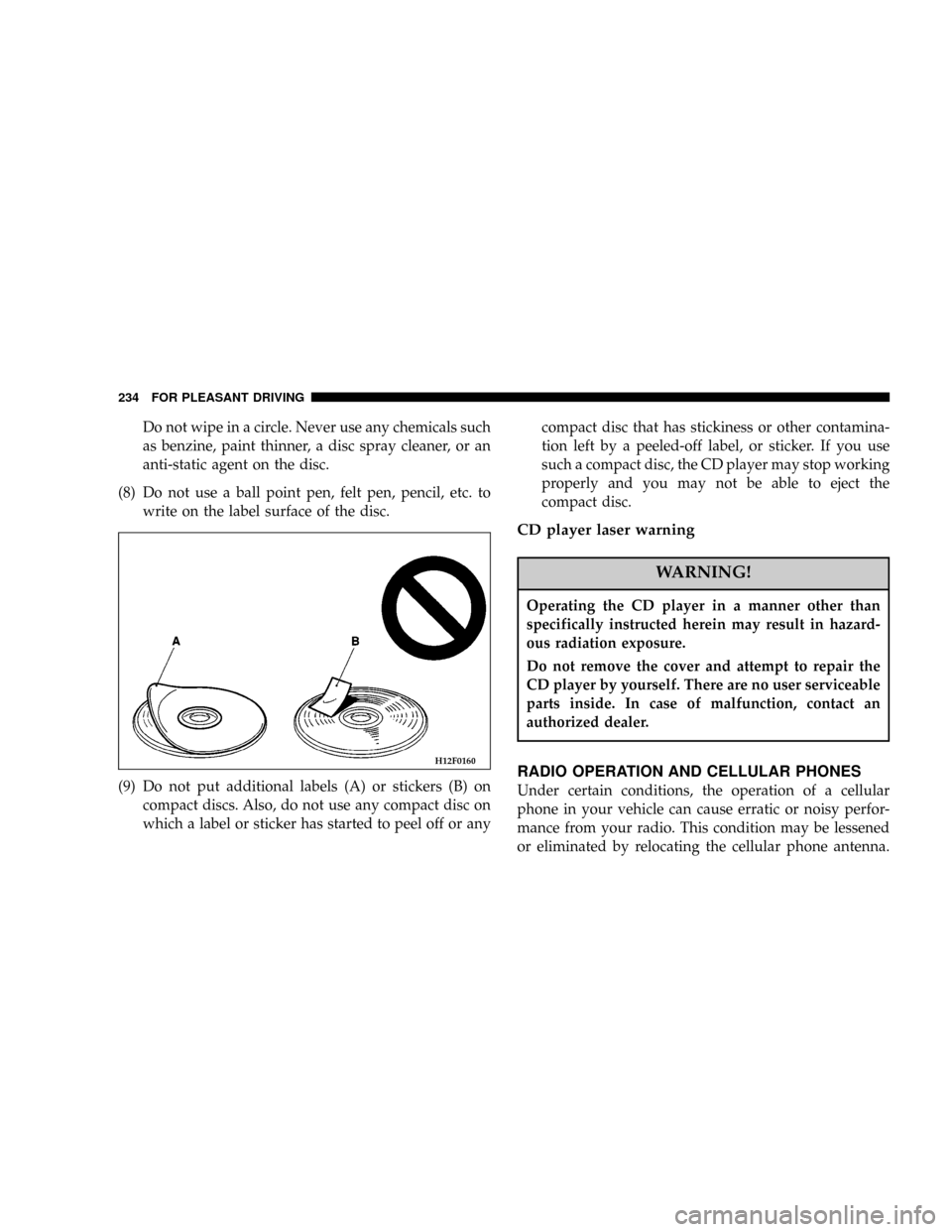
Do not wipe in a circle. Never use any chemicals such
as benzine, paint thinner, a disc spray cleaner, or an
anti-static agent on the disc.
(8) Do not use a ball point pen, felt pen, pencil, etc. to
write on the label surface of the disc.
(9) Do not put additional labels (A) or stickers (B) on
compact discs. Also, do not use any compact disc on
which a label or sticker has started to peel off or anycompact disc that has stickiness or other contamina-
tion left by a peeled-off label, or sticker. If you use
such a compact disc, the CD player may stop working
properly and you may not be able to eject the
compact disc.
CD player laser warning
WARNING!
Operating the CD player in a manner other than
specifically instructed herein may result in hazard-
ous radiation exposure.
Do not remove the cover and attempt to repair the
CD player by yourself. There are no user serviceable
parts inside. In case of malfunction, contact an
authorized dealer.
RADIO OPERATION AND CELLULAR PHONES
Under certain conditions, the operation of a cellular
phone in your vehicle can cause erratic or noisy perfor-
mance from your radio. This condition may be lessened
or eliminated by relocating the cellular phone antenna.
H12F0160
234 FOR PLEASANT DRIVING
Page 263 of 394
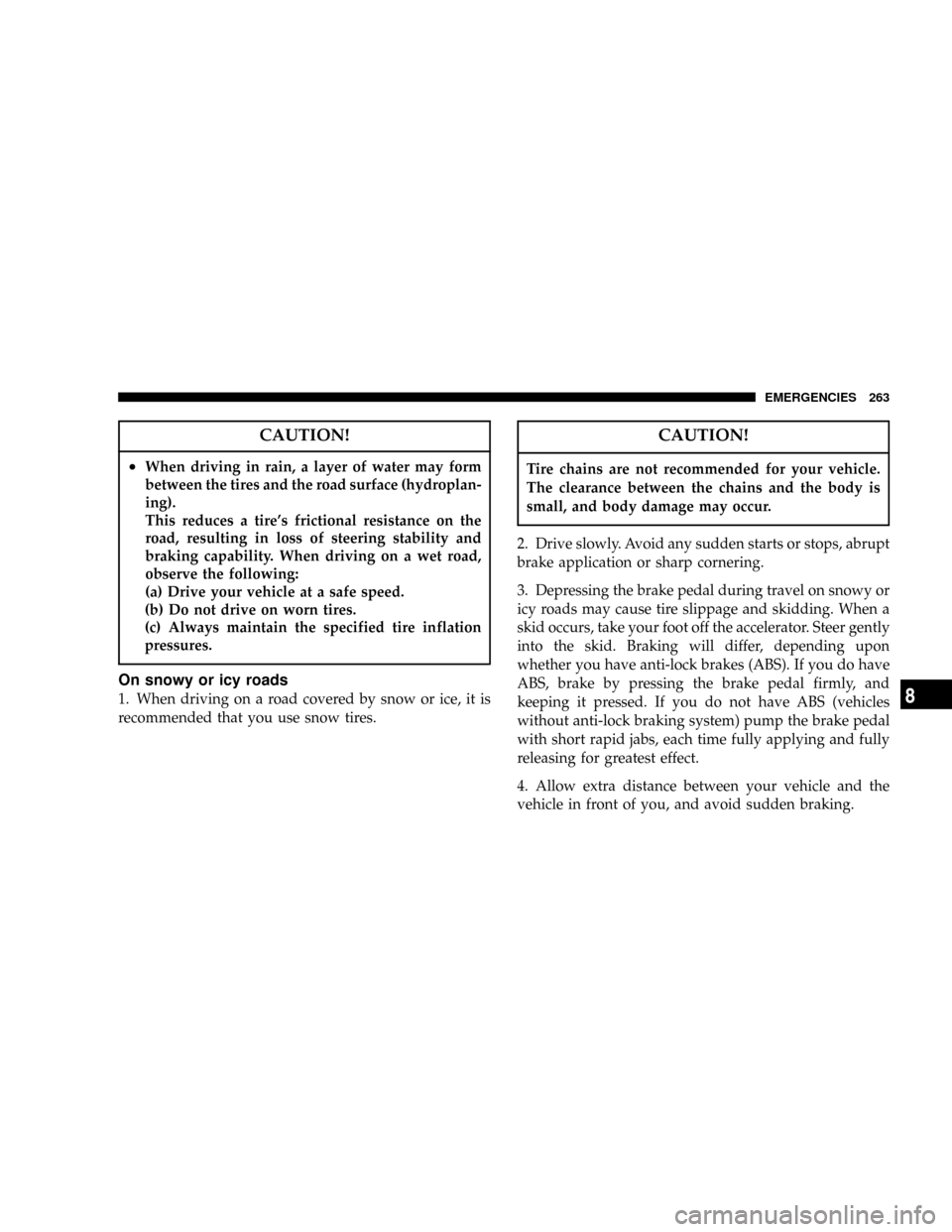
CAUTION!
²When driving in rain, a layer of water may form
between the tires and the road surface (hydroplan-
ing).
This reduces a tire's frictional resistance on the
road, resulting in loss of steering stability and
braking capability. When driving on a wet road,
observe the following:
(a) Drive your vehicle at a safe speed.
(b) Do not drive on worn tires.
(c) Always maintain the specified tire inflation
pressures.
On snowy or icy roads
1. When driving on a road covered by snow or ice, it is
recommended that you use snow tires.
CAUTION!
Tire chains are not recommended for your vehicle.
The clearance between the chains and the body is
small, and body damage may occur.
2. Drive slowly. Avoid any sudden starts or stops, abrupt
brake application or sharp cornering.
3. Depressing the brake pedal during travel on snowy or
icy roads may cause tire slippage and skidding. When a
skid occurs, take your foot off the accelerator. Steer gently
into the skid. Braking will differ, depending upon
whether you have anti-lock brakes (ABS). If you do have
ABS, brake by pressing the brake pedal firmly, and
keeping it pressed. If you do not have ABS (vehicles
without anti-lock braking system) pump the brake pedal
with short rapid jabs, each time fully applying and fully
releasing for greatest effect.
4. Allow extra distance between your vehicle and the
vehicle in front of you, and avoid sudden braking.
EMERGENCIES 263
8
Page 272 of 394
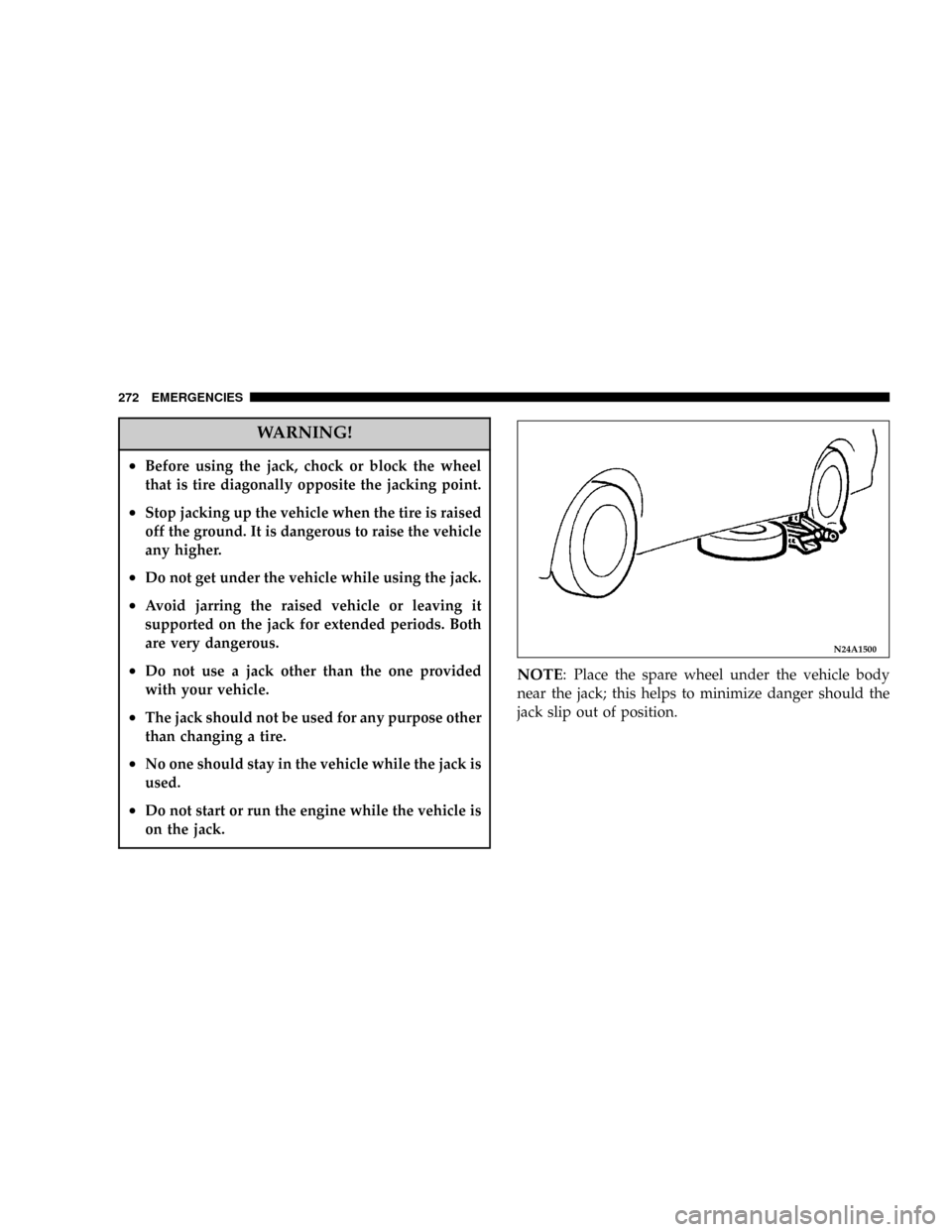
WARNING!
²Before using the jack, chock or block the wheel
that is tire diagonally opposite the jacking point.
²Stop jacking up the vehicle when the tire is raised
off the ground. It is dangerous to raise the vehicle
any higher.
²Do not get under the vehicle while using the jack.
²Avoid jarring the raised vehicle or leaving it
supported on the jack for extended periods. Both
are very dangerous.
²Do not use a jack other than the one provided
with your vehicle.
²The jack should not be used for any purpose other
than changing a tire.
²No one should stay in the vehicle while the jack is
used.
²Do not start or run the engine while the vehicle is
on the jack.
NOTE: Place the spare wheel under the vehicle body
near the jack; this helps to minimize danger should the
jack slip out of position.
N24A1500
272 EMERGENCIES
Page 309 of 394
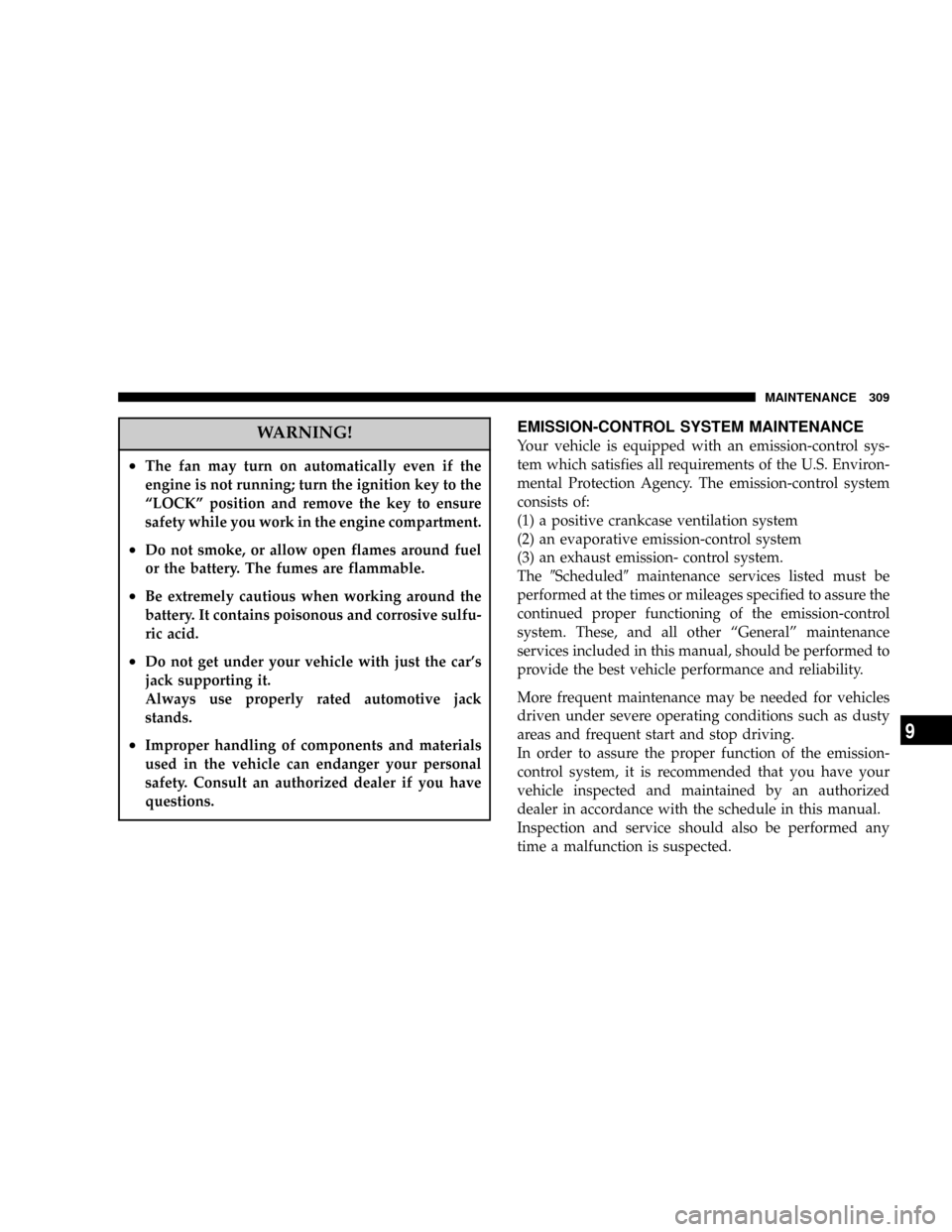
WARNING!
²The fan may turn on automatically even if the
engine is not running; turn the ignition key to the
ªLOCKº position and remove the key to ensure
safety while you work in the engine compartment.
²Do not smoke, or allow open flames around fuel
or the battery. The fumes are flammable.
²Be extremely cautious when working around the
battery. It contains poisonous and corrosive sulfu-
ric acid.
²Do not get under your vehicle with just the car's
jack supporting it.
Always use properly rated automotive jack
stands.
²Improper handling of components and materials
used in the vehicle can endanger your personal
safety. Consult an authorized dealer if you have
questions.
EMISSION-CONTROL SYSTEM MAINTENANCE
Your vehicle is equipped with an emission-control sys-
tem which satisfies all requirements of the U.S. Environ-
mental Protection Agency. The emission-control system
consists of:
(1) a positive crankcase ventilation system
(2) an evaporative emission-control system
(3) an exhaust emission- control system.
The9Scheduled9maintenance services listed must be
performed at the times or mileages specified to assure the
continued proper functioning of the emission-control
system. These, and all other ªGeneralº maintenance
services included in this manual, should be performed to
provide the best vehicle performance and reliability.
More frequent maintenance may be needed for vehicles
driven under severe operating conditions such as dusty
areas and frequent start and stop driving.
In order to assure the proper function of the emission-
control system, it is recommended that you have your
vehicle inspected and maintained by an authorized
dealer in accordance with the schedule in this manual.
Inspection and service should also be performed any
time a malfunction is suspected.
MAINTENANCE 309
9
Page 323 of 394
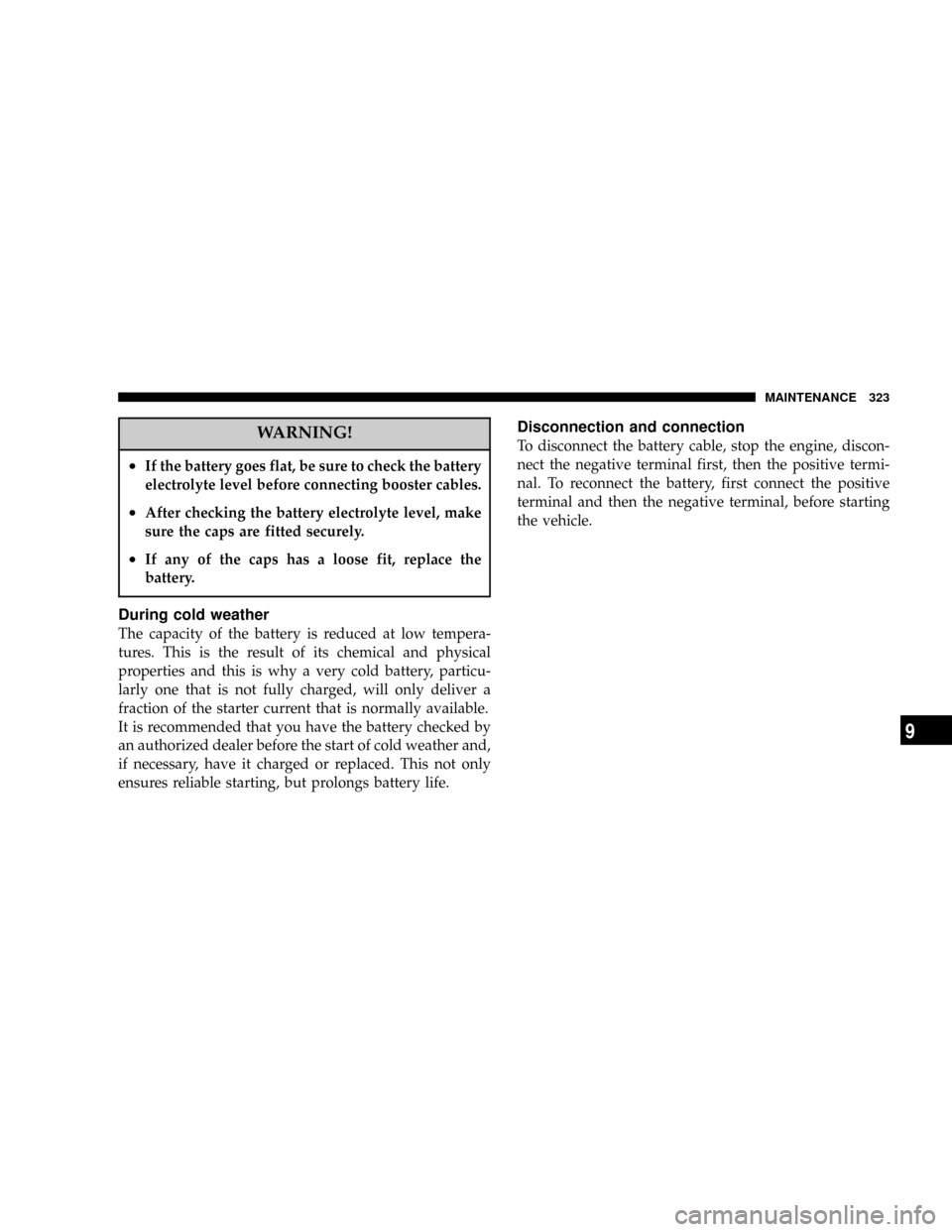
WARNING!
²If the battery goes flat, be sure to check the battery
electrolyte level before connecting booster cables.
²After checking the battery electrolyte level, make
sure the caps are fitted securely.
²If any of the caps has a loose fit, replace the
battery.
During cold weather
The capacity of the battery is reduced at low tempera-
tures. This is the result of its chemical and physical
properties and this is why a very cold battery, particu-
larly one that is not fully charged, will only deliver a
fraction of the starter current that is normally available.
It is recommended that you have the battery checked by
an authorized dealer before the start of cold weather and,
if necessary, have it charged or replaced. This not only
ensures reliable starting, but prolongs battery life.
Disconnection and connection
To disconnect the battery cable, stop the engine, discon-
nect the negative terminal first, then the positive termi-
nal. To reconnect the battery, first connect the positive
terminal and then the negative terminal, before starting
the vehicle.
MAINTENANCE 323
9